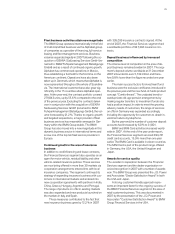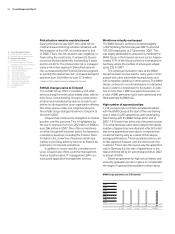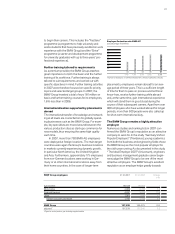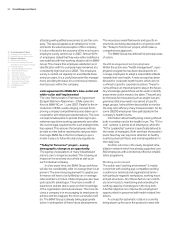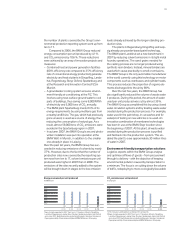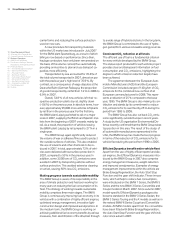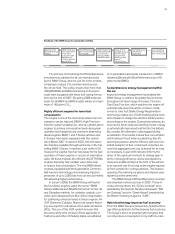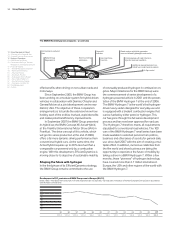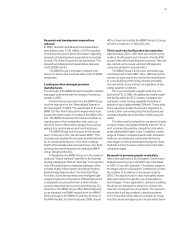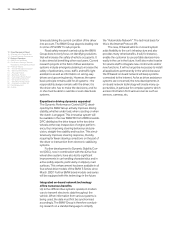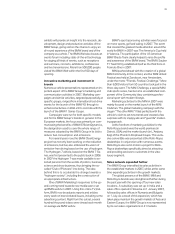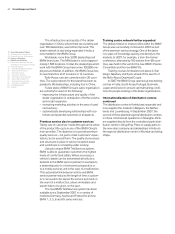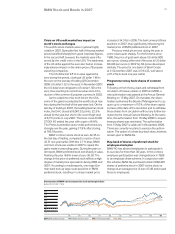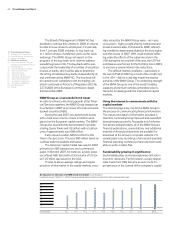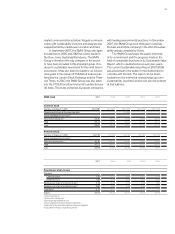BMW 2007 Annual Report Download - page 35
Download and view the complete annual report
Please find page 35 of the 2007 BMW annual report below. You can navigate through the pages in the report by either clicking on the pages listed below, or by using the keyword search tool below to find specific information within the annual report.
33
The principle of introducing the EfficientDynamics
innovations as standard for all cars manufactured
by the BMW Group, and not just for niche models,
is helping to reduce CO2 emission levels across
the whole fleet. This policy means that more than
450,000 BMW and MINI cars driving on Europe’s
roads were equipped with these fuel-saving innova-
tions by the end of 2007. By spring 2008 emission
levels for 26 BMW and MINI models will be at a maxi-
mum of 140 g/km CO2.
Highly efficient engines for lower fuel
consumption
The engine is one of the main areas where fuel con-
sumption can be reduced. BMW’s High Precision
Injection system enables four- and six-cylinder petrol
engines to achieve consumption levels during lean
operation that had previously only been attained by
diesel engines. BMW 1 and 5 Series vehicles sold
in Europe have been equipped with this system
since March 2007. In autumn 2007, this innovation
also became available throughout Europe in the top-
selling BMW 3 Series. In markets such as the USA,
however, the sulphur-free fuel necessary for the lean
operation of these engines is not yet on sale nation-
wide. On these markets, the efficient VALVETRONIC
engines featuring fully variable valve drive help
to reduce
fuel consumption. The new BMW diesel
engines, equipped with third-generation Common-
Rail injection technology and employing injection
pressures of up to 2,000 bar, now use less fuel whilst
still delivering higher performance.
In autumn 2008, the BMW Group will launch
the first diesel engines under the name BMW
AdvancedDiesel with BluePerformance on the US
and Cana dian markets. An oxidation catalytic con-
verter and a diesel particle filter will be responsible
for optimising emission levels in these engines. An
SCR (Selective Catalytic Reduction) system featur-
ing urea injection will reduce nitric oxide emissions
(NOx). The use of this SCR system ensures that
the particularly strict emission limits applicable in
California and other US federal states are adhered
to. It will enable nationwide introduction of BMW
AdvancedDiesel with BluePerformance as a 50-
state model (BIN5).
Comprehensive energy management within
the car
Improved energy management has enabled the
BMW Group to achieve far greater fuel economy
throughout its latest range of models. The Auto
Start Stop Function, which switches the engine off
automatically when the vehicle comes to a halt,
serves to save fuel. Brake Energy Regeneration
technology makes use of both braking and acceler-
ation phases to charge the vehicle’s battery and re-
duces drag on the engine. During these phases, as
soon as the driver stops accelerating, kinetic energy
is automatically harnessed and fed into the battery.
By contrast, the alternator is disengaged during
acceleration. This results in lower fuel consumption
and maximum thrust when accelerating. Electric
steering assistance and the efficient, demand-con-
trolled operation of fuel, coolant and oil pumps en-
sure that aggregates are only activated for as long
as necessary. A gear shift indicator informs the
driver of the optimum moment to change gear in
terms of energy efficiency. Active aerodynamics
measures enable air flaps at the front of the vehicle
to be opened only for as long as the engine requires
air from outside for cooling purposes. This helps to
speed up the warming-up phase and improve aero-
dynamics at the same time.
The BMW Group’s EfficientDynamics concept
was awarded numerous prizes in 2007. These in-
clude, among others, the Grüne Lenkrad prize
awarded by the German Sunday newspaper Bild
am Sonntag and the Green Award presented by
the British motoring magazine CAR.
Hybrid technology improves fuel economy
From the BMW Group’s perspective, hybrid technol-
ogy offers potential to further improve fuel economy.
The Group’s aim is to develop hybrid engines that
not only reduce consumption in city traffic but also
>
Roadmap of the BMW Group for sustainable mobility
Adoption of the
EfficientDynamics
strategy
.
BMW Group cuts
fuel consumption
in Germany
pursuant to VDA
agreement of
1990 by 2005 by
almost 30 %.
2006 BMW Hydro-
gen 7 is presented
to the public.
2007 Introduction
of EfficientDynam-
ics measures in
numerous BMW
and MINI models.
About 40 % of
the
BMW Group’s
new vehicles in
Europe will be
emitting a maxi-
mum of
140 g CO2/km.
First BMW Group
vehicles with
hybrid drive.
Use of regenera-
tive hydrogen as
fuel in motor traffic.
2000 2005 2006 2007 2008 2009 long-term
>>>>> >




